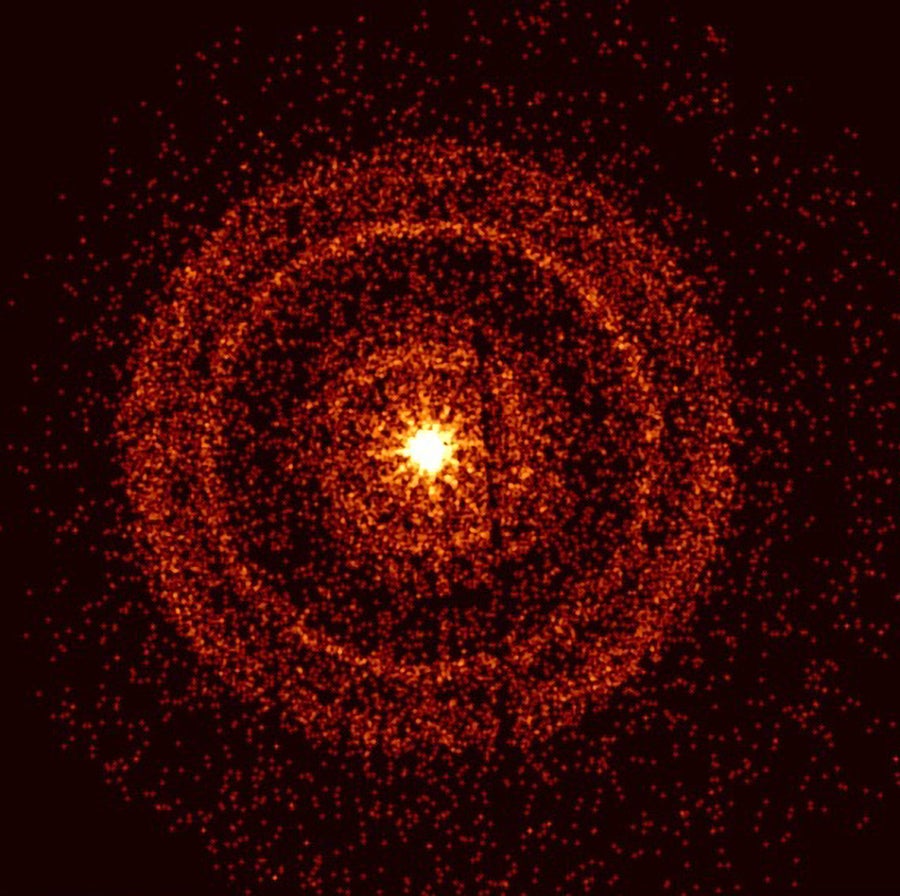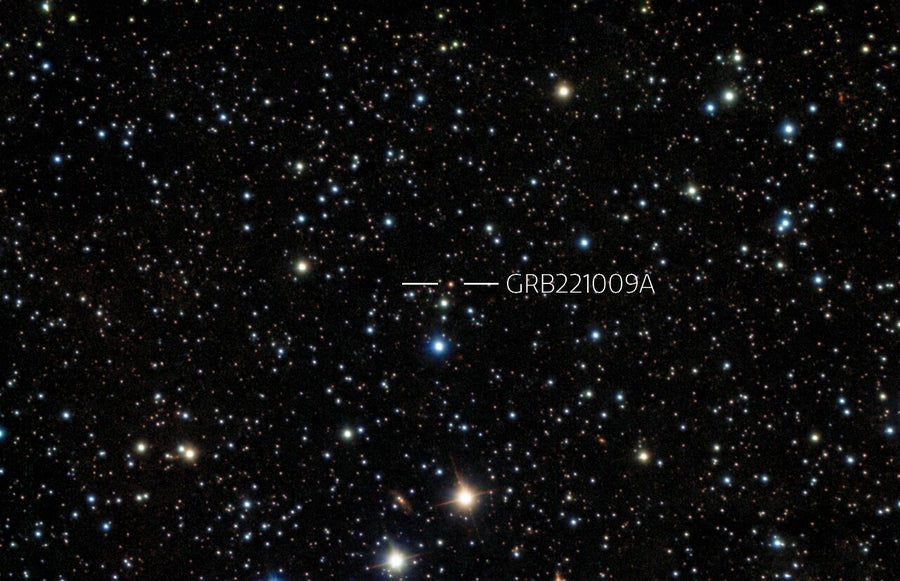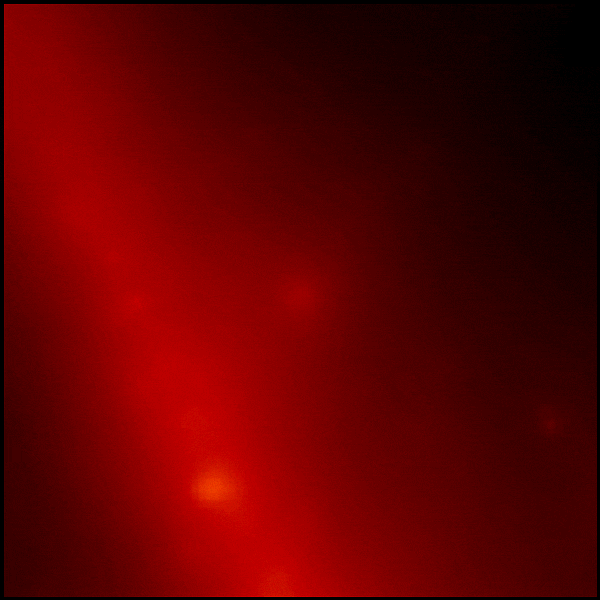In early October 2022 a wave of high-energy radiation swept over Earth from a gamma-ray burst, one of the most singularly catastrophic and violent events the cosmos has to offer. Astronomers quickly determined its distance and found it was the closest such burst ever seen: a mere two billion light-years from Earth. Or, if you prefer, 20 billion trillion kilometers away from us, a decent fraction of the size of the observable universe.
To astronomers, “close” means something different. This one was so close, cosmically speaking, that it was detected by a fleet of observatories both on and above Earth, and it is already yielding a trove of scientific treasure. But even from this immense distance in human terms, it was the brightest such event ever seen in x-rays and gamma rays, bright enough for people to spot its visible-light emission in smaller amateur telescopes, and was even able to physically affect our upper atmosphere. Despite that, this gamma-ray burst poses no danger to us. Either way, I’m glad they keep their distance.
Gamma-ray bursts, or GRBs, are intense blasts of gamma rays—the highest-energy form of light—that typically last from a fraction of a second to a few minutes in length. Gamma-ray bursts have been a puzzle to astronomers since the cold war, when the first one was discovered in the 1960s by orbiting detectors looking for nuclear weapons tested on or above Earth. More than 1,700 have been observed since then. Still, it took decades to pin any of them down well enough in the sky to observe them with more conventional telescopes and to understand better what they were. Even then it was difficult, as each GRB has idiosyncrasies, making them complicated to understand as a group.
On supporting science journalism
If you're enjoying this article, consider supporting our award-winning journalism by subscribing. By purchasing a subscription you are helping to ensure the future of impactful stories about the discoveries and ideas shaping our world today.
Nevertheless, we do have a decent grasp of their basic nature. Short-duration bursts—generally a few seconds long at most—come from two superdense neutron stars colliding and blasting out fierce energy, whereas long-duration ones—lasting several minutes—come from massive stars exploding at the ends of their lives. The core of the star collapses, forming a black hole. A swirling disk of material that wasn’t immediately swallowed by the black hole rapidly forms around it, funneling twin beams of intense energy out into space, one pointing up and the other down, away from the disk. These eat their way through the dying star and erupt outward while the rest of the star explodes as a very powerful supernova.

Taken just an hour after the first blast of light from GRB 221009A, this Neil Gehrels Swift Observatory image shows rings of x-ray light from the gamma-ray burst scattered by dust inside our Milky Way galaxy. Credit: NASA/Swift/A. Beardmore (University of Leicester)
The energy in gamma-ray bursts is almost incomprehensible: In a few seconds they can emit as much energy as the sun will over its entire 12-billion-year life span. Their power comes from their tight focus; these thin beams concentrate the explosive energy in a very narrow direction. If the beam happens to be pointed your way, you see a flash of gamma rays bright enough to be detected even from many billions of light-years distant. Outside the path you see a more typical supernova.
Despite their power, most bursts are at such a vast distance from us that their light is dimmed dramatically, and a telescope is needed to see them at all.
Dubbed GRB 221009A—for the first gamma-ray burst seen on October 9—its initial flash was first detected by sensors on the orbiting Fermi Gamma-ray Space Telescope, designed specifically to detect and rapidly find the locations of GRBs. Even for a long-duration burst, it was unusually extended. Another blast of gamma rays was spotted by the Neil Gehrels Swift Observatory, another orbiting set of telescopes designed to observe bursts. That second peak happened nearly an hour later, much later than usual for such events, indicating just how much power this particular GRB had at its disposal.

The afterglow from GRB 221009A was seen five days after the initial blast using the huge Gemini South telescope in Chile. This image shows it in near-infrared light, just outside what the human eye can see. Credit: International Gemini Observatory/NOIRLab/NSF/AURA/B. O’Connor (UMD/GWU) and J. Rastinejad and W. Fong (Northwestern University); Image processing: T.A. Rector (University of Alaska Anchorage/NSF’s NOIRLab), J. Miller, M. Zamani and D. de Martin (NSF’s NOIRLab) (CC BY 4.0)
Swift immediately sent out an automated alert to astronomers all over the world, who responded by pointing their own telescopes toward the burst. The fading glow of visible light, caused by the beams slamming into matter surrounding the dying star, revealed its distance via cosmic redshift (a reddening of light caused by the expansion of the universe itself) and indicated this was the closest GRB ever seen.
A tweet by astrophysicist Rami Mandow pointed out that lightning detectors in India and Germany showed that the way pulses of electromagnetic radiation from lightning propagated changed suddenly at the same time the GRB energy hit our planet. These pulses indicate conditions in Earth’s upper atmosphere changed, with electrons suddenly stripped from their host atoms. Gamma rays ionize atoms in this way, so it seems very likely that this blast physically affected our planet’s atmosphere, though only mildly and briefly. Still, from two billion light-years away, that’s an extraordinary phenomenon.
A GRB this close means that astronomers can analyze the light they see from it in more ways than usual. Typically a burst’s light isn’t bright enough to clearly reveal details about the event that caused it. This specimen could help scientists better understand the central black hole engine that forms during a burst and the extraordinarily complex nature of the physics surrounding it.
It can also tell us about the Milky Way. The Swift observatory saw expanding rings of x-ray light centered on the GRB’s location, caused by dust clouds in the Milky Way located roughly 600 to 12,000 light-years from Earth. These “light echoes” happen when light hits dust clouds just off our line of sight to the GRB—so we see them to the side, next to the bright point in the sky. Because of the short amount of extra time it takes light from the blast to reach those dust clouds and be scattered toward us, we see rings of light moving outward from the center, their expansion rate related to their distance from us. Measuring these rings allowed astronomers to determine the distances to the clouds.
Although great strides have been made, especially since the 1990s when the first bursts were seen by optical telescopes and their distances were determined to be literally cosmic, there is much about them we have yet to understand. GRB 221009A is still being observed by telescopes around the world, and it may prove to be a Rosetta stone for these wildly diverse, bizarre and powerful events.”
Editor’s Note:This is the first of a new monthly column by astronomer and writer Phil Plait. Plait is a former Hubble Space Telescope researcher and has written numerous books and articles about space, including for ScientificAmerican.com
